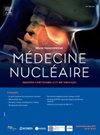Presurgical [68Ga]-Ga-PSMA-11 Positron Emission Tomography as a surrogate of pelvic lymph node dissection for biochemical recurrence risk assessment
IF 0.2
4区 医学
Q4 PATHOLOGY
Medecine Nucleaire-Imagerie Fonctionnelle et Metabolique
Pub Date : 2025-03-01
DOI:10.1016/j.mednuc.2025.01.154
引用次数: 0
Abstract
Purpose
To compare the prognostic value for biochemical recurrence (BCR) free-survival (FS) of a CAPRA-S score (Cancer of the Prostate Risk Assessment) calculated replacing pelvic lymph node dissection (PLND) information with pre-operative PSMA PET findings (CAPRA-S-PSMA).
Methods
This is a follow-up study of the surgery cohort included in the multicenter prospective phase 3 imaging trial (n = 277; NCT03368547, NCT02611882, NCT02919111). Local histopathology score (CAPRA-S score without PLND), PSMA-PET N1/M1, and pN1 were used to assess risk of BCR. Patients were followed up after RP by the local investigators using electronic medical records. BCR was defined by a prostate-specific antigen (PSA) level ≥ 0.2 ng/mL after RP or an initiation of PCa specific secondary treatment (> 6 months after surgery). Univariate, multivariate Cox model, and c-statistic index were performed to assess the prognostic value of PSMA-PET, pN1 and its added value to local histopathology risk score.
Results
From December 2015 to 2019, 277 patients underwent surgery after PSMA-PET. Clinical follow-up was obtained in 240/277 (87%) patients. PSMA-PET N1/M1 and pN1 were found in 41/240 (17%) and 67/240 (28%) patients respectively. Median follow-up from surgery was 32.4 (IQR 23.3–42.9) months. 91/240 BCR events (38%) were observed. Only local histopathology score and PSMA PET were significant in multivariate analysis for BCR-FS (HR [95%CI]: 1.4 [1.2–1.5] P < 0.0001) and (1.7 [1–2.9] P = 0.03). Prognostic value of model CAPRA-S-PSMA was not significantly different than model CAPRA-S-PLND (c-statistic 0.74 [0.69–0.79] vs. 0.73 [0.68–0.78]; P = 0.69).
Conclusion
Switching PLND information by pre-surgical PSMA PET extra prostatic findings in the reference CAPRA-S score showed no significant difference in predicting BCR-FS in patients with intermediate-risk to high-risk PCa.
术前[68Ga]-Ga-PSMA-11正电子发射断层扫描替代盆腔淋巴结清扫进行生化复发风险评估
目的比较CAPRA-S评分(前列腺癌风险评估)替代盆腔淋巴结清扫(PLND)信息与术前PSMA PET结果(CAPRA-S-PSMA)对生化复发(BCR)自由生存(FS)的预后价值。方法:这是一项纳入多中心前瞻性3期影像学试验(n = 277;Nct03368547, nct02611882, nct02919111)。局部组织病理学评分(CAPRA-S评分,无PLND)、PSMA-PET N1/M1和pN1用于评估BCR的风险。RP后由当地调查人员使用电子病历对患者进行随访。前列腺特异性抗原(PSA)水平≥0.2 ng/mL定义为BCR, RP或PCa特异性二次治疗开始后(>;术后6个月)。采用单因素、多因素Cox模型和c统计指数评估PSMA-PET、pN1的预后价值及其对局部组织病理学风险评分的附加价值。结果2015年12月至2019年12月,277例患者接受了PSMA-PET手术。240/277例(87%)患者获得临床随访。PSMA-PET N1/M1和pN1分别在41/240(17%)和67/240(28%)患者中检出。手术后中位随访时间为32.4个月(IQR 23.3-42.9)。观察到91/240例BCR事件(38%)。在BCR-FS的多变量分析中,只有局部组织病理学评分和PSMA PET具有显著性(HR [95%CI]: 1.4 [1.2-1.5] P <;0.0001)和(1.7 [1-2.9]P = 0.03)。CAPRA-S-PSMA模型与CAPRA-S-PLND模型的预后价值差异无统计学意义(c统计量0.74[0.69-0.79]比0.73 [0.68-0.78];p = 0.69)。结论术前PSMA PET前列腺外检查结果与参考CAPRA-S评分转换PLND信息在预测中危至高危PCa患者BCR-FS方面无显著差异。
本文章由计算机程序翻译,如有差异,请以英文原文为准。
求助全文
约1分钟内获得全文
求助全文
来源期刊
CiteScore
0.30
自引率
0.00%
发文量
160
审稿时长
19.8 weeks
期刊介绍:
Le but de Médecine nucléaire - Imagerie fonctionnelle et métabolique est de fournir une plate-forme d''échange d''informations cliniques et scientifiques pour la communauté francophone de médecine nucléaire, et de constituer une expérience pédagogique de la rédaction médicale en conformité avec les normes internationales.

 求助内容:
求助内容: 应助结果提醒方式:
应助结果提醒方式:


